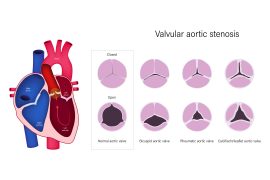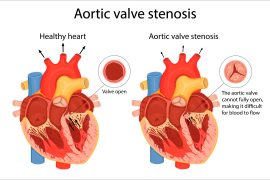When it comes to ailments of the heart, Aortic Stenosis (AS) is one of the most common diseases, especially when it comes to senior citizens. It occurs when the opening of the aortic valve gets narrowed. Through the right intervention, Aortic Stenosis can be tackled. But to do so, one needs to know what the ailment entails.
As mentioned, Aortic Stenosis is a disease that is more likely to occur among the elderly. That is why, on the eve of Senior Citizens Day, Dr. Karun Behal (MD, DM – Cardiology), Senior Consultant – Cardiology, Fortis Mohali, held a live session online where the specialist shared some vital insights on the ailment and various interventions that can be used to surpass it. Read on to know these key pointers from the live session.
To start with, what is Aortic Stenosis?
In aortic stenosis, the Aortic valve doesn’t open completely, restricting the blood flow from the left ventricle of the heart to the aorta and the rest of the body. It may also affect the pressure in the left atrium.
The aortic valve has three leaflets, and it separates the aorta from the left ventricle. The main function of the aortic valve is to open and allow blood flow from the left ventricle of the heart to the aorta, through which blood flows to the rest of the body. It also prevents the backflow of blood from the aorta to the left ventricle. Aortic stenosis happens when the valve doesn’t open up completely, which in turn reduces or blocks the blood flow. Dr. Behal also mentioned that aortic stenosis is more prevalent in the elderly population.
How is Aortic Stenosis diagnosed?
Dr. Behal opined that to treat this condition, it is important to determine if the symptoms are mild, moderate, or severe. Depending on the severity of the condition, the right treatment method is suggested.
Aortic stenosis can be diagnosed clinically, where your doctor will use a stethoscope to look out for heart murmurs that may suggest an aortic valve condition. The doctor may also run several tests such as Echocardiography, which uses sound waves to create images of your heart. Echocardiography can also show the doctor how blood flows through the heart valves, and if there is an interference in the blood flow.
What are the symptoms of Aortic Stenosis that one needs to look out for?
Most cases of aortic stenosis are asymptomatic, or the symptoms are visible only during the later stages. Some of the most common symptoms of aortic stenosis are:
- Heaviness/pain in the chest while indulging in physical activities
- Shortness of breath
- Fatigue
- Dizziness
- Palpitations
If these above-mentioned symptoms are persistent, it is important to talk to your medical practitioner immediately to diagnose aortic stenosis.
How is Aortic Stenosis treated?
Initially, aortic stenosis was treated through medications such as pain killers, blood thinners, and medicines that kept cholesterol levels and blood pressure in check, but it did not work on people with severe aortic stenosis. But nowadays, with the advancements in the medical field, severe aortic stenosis can be treated. Some of the most common treatment methods for aortic stenosis are:
Surgical Aortic Valve Replacement (SAVR): Surgery is one of the most popular methods to treat aortic stenosis. This is usually done through an incision in the chest. People who have undergone surgery for aortic stenosis have a better survival rate. However, surgery may not be recommended to elderly patients with aortic stenosis as it may lead to several health complications.
Transcatheter Aortic Valve Replacement (TAVR): This is a less invasive procedure for those who are at a higher risk of complications from surgical aortic valve replacement. In this procedure, the damaged valve is replaced with a bioprosthetic valve.
What are the advantages of TAVR?



TAVR is a huge advancement in the field of medical sciences in the past 15-20 years. Due to its less invasive nature, TAVR has replaced open-heart surgeries. At first, TAVR was recommended to only those patients who were unfit for surgery. An open heart surgery involves attaching a heart-lung bypass machine to the patient and opening the chest cavity, which may lead to several complications. Post-surgery, the patient would have to be under observation for 10-12 days, and the recovery would take about 1 – 2 months.
However, with TAVR, the chances of complications are reduced, and the patient can be discharged within 2-3 days of the procedure. The rate of recovery is also faster compared to SAVR. However, SAVR is cost-efficient in comparison to TAVR.
Many patients and caregivers who had joined in on the session had questions for Dr. Behal, especially on the long-term consequences of the ailment. Here are a few of them.
Can Aortic Stenosis cause sudden death?
Yes, aortic stenosis can cause sudden death, as the symptoms are not visible in the earlier stages. The patients do not recognize the signs until the later stages, during which treatment might be difficult, which may lead to sudden heart failure. The patients need to be mindful of the early signs and approach the doctor immediately to run diagnostic tests.
Does mild Aortic Stenosis require surgery?
No. SAVR and TAVR are recommended for those who are diagnosed with severe aortic stenosis. Mild and moderate symptoms can be treated with medications. However, the patient must frequently follow up with the medical practitioner to ensure that the symptoms do not worsen.
How long does a TAVI valve last?
In SAVR, two different types of valves are used – biological valves and prosthetic valves. Biological valves are made of animal tissues and last for about 10-15 years, while prosthetic valves are made of metal and last for about 20-25 years.
In TAVR, biological valves are used, and they last for 10-15 years.
What is the survival rate in Aortic Stenosis patients?
Aortic stenosis can either be asymptomatic or symptomatic. If the patient is asymptomatic and responds well to stress tests and other diagnostic tests, the outlook is positive, almost equivalent to the normal healthy adult population.
However, if the symptoms are severe, the outlook is negative. At this stage, it is important to run tests such as echocardiography to determine the damage done to the valve, and the treatment must be administered immediately.
What is the minimum age to undergo TAVI?
Initially, people above the age of 65 – 70 are considered for TAVI. And it is advisable for everyone above 75 to only opt for TAVR as the procedure is less invasive.
Does TAVR have any side effects?
Though TAVR is less invasive as compared to SAVR, there are several risks and complications associated with the procedure:
- Internal bleeding
- Pain
- Stroke
- Arrhythmia, requiring pacemaker implantation
- Death
Who qualifies for the TAVR procedure?
TAVR is mostly recommended to patients who display severe symptoms. After being diagnosed with aortic stenosis, it is necessary to discuss with your heart surgeon about the advantages and disadvantages of SAVR and TAVR, to decide the right treatment method for you. Sometimes, TAVR is also recommended for patients with moderate symptoms.
While diseases like Aortic Stenosis are indeed common, leading a healthy lifestyle & timely intervention by your doctor can help go a long way in keeping the disease at bay!





Comments are closed.